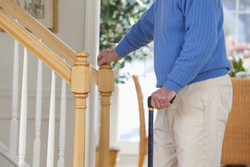Smart technologies to the rescue of fall-prone seniors
It is often a heartbreaking moment when a family is forced to place their elderly relatives in a nursing home. But it is also, to a certain extent, a source of relief: each year, 35 % of over 65 years-old experience one or more falls, and this percentage rises as we grow older. Such falls can result in serious injury and even death, which means that enjoying a fully independent retirement at home is not always an option. Even in the safest nursing homes, a few seconds of inattention can have serious consequences and the absence of witnesses or monitoring systems in real world situations means the circumstances of these falls often remain unknown. But what if smart devices could help us better predict and prevent these falls? With its new technological infrastructure, its fall repository, a telemedicine service, a brand new fall algorithm, and extensive research into users’ interactions with technology, the FARSEEING project has made independent living a realistic option even for high risk subjects, while taking their opinions and expectations into account thanks to real life testing. Completed in May 2015, the project offers a 360 degree perspective on how to prevent, detect and manage falls in various environments. The FARSEEING technology relies on two core components. First, a smart home system tracks the user’s movements in the house thanks to environmental sensors and a distributed audio and video system. The data is collected and processed by means of a local unit, and a so-called ‘scenario programmer’ is set up to define and manage up to 300 fall scenarios. These scenarios can either be triggered by the user himself/herself or by events like door openings, movements, temperature changes or detected falls. The system is backed by smart wearables and smartphones, with applications including a dedicated smartphone app featuring a real-time fall detection algorithm, and a novel smart shoe-based activity monitoring system. ‘Our system offers better fall prediction, as well as the potential to understand what happens physically before someone falls and set up preventive measures accordingly,’ explains Prof. Lorenzo Chiari, coordinator of the project and vice-director of the Health Sciences and Technologies – Interdepartmental Center for Industrial Research (HST-ICIR) at the University of Bologna. ‘Preliminary results about the predictive validity of the smartphone-based assessment are available and show that, by instrumenting the Timed Up and Go test – a traditional clinical test – using smartphones, we can measure fine details of movement which are strongly associated with the history of falls and, more importantly, features, such as the smoothness of the sit-to-walk transition, that are highly predictive of the probability of falling within 6 months,’ he continues. Besides prediction, prevention was also an important part of the research, as the team tested various exercise video games available on the market and provided recommendations for the development of new games specifically dedicated to older people. The world’s largest fall repository But the project goes beyond the prevention and solving of individual fall scenarios: all data collected by FARSEEING sensors feeds into a fall repository – the world’s largest, according to the project team – where relevant features in the user’s motor profile and functional level, predictive of future falls, are stored. ‘The falls repository contains information from over 200 real-world fall events,’ Prof. Chiari notes. ‘Falls have been measured in different settings like community dwelling, rehabilitation clinic and nursing home, and in different disease groups – mainly geriatric rehabilitation, Parkinson’s disease, cerebellar and sensory ataxia. Based on this data a new classification system has been established to help improve detection of falls from sensor data.’ The system will soon be open to any external parties interested in contributing to or using this database, which will be accessible from the project’s website. To maximise the exploitation potential of the data, the consortium even created a common language between researchers, engineers, users and health professionals, to ensure consistency in study descriptions and reporting. Although the project, which received an ‘excellent’ rating from the Commission, is now completed, work will continue over the coming months. First, some of the results of FARSEEING are been transferred to empower fall risk assessment in a Randomised Control Trial about fall prevention (the Precisa study) funded by the Emilia-Romagna Health & Care Agency. Then, a spin off company, mHealth Technologies, has been set up by researchers at the University of Bologna to exploit the smartphone system developed as part of FARSEEING. The company has already had preliminary contacts with potential customers to exploit the system, while some members of the FARSEEING consortium have recently been awarded further EC funding under the Horizon2020 PREVENTIT project to deliver a feasibility trial to further develop it. ‘This is just a start,’ Prof. Chiari concludes. ‘Our plan is to continue building on our work to maximise the opportunities provided by ICT within the field of fall prediction, detection and prevention.’ For further information, please visit: FARSEEING http://farseeingresearch.eu/
Countries
Italy



